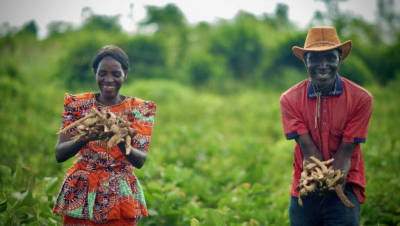How to Strategically Change Pervasive Narratives in Communities
How to Strategically Change Pervasive Narratives in Communities
Gender equality measures are a powerful catalyst for socio-economic development
Gender equality measures are a powerful catalyst for socio-economic development

Rosemary & husband at their Canavalia ensiformis multiplication farm
Photo: ©Njiri/GIZ
“How important it is for us to recognize and celebrate our heroes and she-roes!”, American poet, memoirist, and civil rights activist Maya Angelou once said.
The wise words resonate well with the focus of the Global Programme Soil Protection and Soil Rehabilitation for Food Security’s Kenya country package on engaging both women and men in Western Kenya in the spheres of rural development through sustainable land management practices.
From the advent of the project in 2015, it has remained steadfast in its efforts of ensuring the attainment of healthy soils that play a critical role in supporting agricultural productivity, climate change mitigation and resilience, and a range of ecosystem services. However, this is constrained by the virtue that some key players especially women are left out to play a spectator role.
Within the intervention areas, there are many socio-cultural, economic, and institutional barriers hindering the attainment of gender equality. Notable gender inequalities are manifested through limitations to access to credit, access and use of land as the main factor of production, access to training opportunities among the many challenges they face. These are further aggravated by the food and nutritional insecurities, prevailing economic issues, and effects of climate change. In the face of these, there is a consensus that attaining gender equality is an important pathway for a range of socio-economic benefits to the households and communities at large.
Hence, the country package has continuously worked with strategic partners and closely with the communities in changing this pervasive narrative by works with a communal approach that ensures valuable participation and involvement of women. The project has embraced a multifaceted approach with different stakeholders ranging from governments, private sector, community-based organizations, to faith-based organizations to leverage soil health management while addressing gender inequalities. It’s evident that there is an interconnection between soil health, gender equality and community empowerment.
To this end, the project has identified, flagged, and supports a litany of gendered opportunities to leverage soil health and to address gender inequalities. They include:
- Increasing farm productivity — through conventional composting, vermiculture and vermicomposting
- Earning incomes through sale of vermicompost products, production and sale of biopesticides
- Livelihood improvement through the multiplication of cover crops seeds, value addition of cover crops for sale, sale of animal feeds from cover crops and sale of Nappier grass, Bracharia and Vetiver grass used as vegetative cross slope barriers planting materials
- Provision of paid-up labor through advisory and extension services, provision of tillage services using conservation agriculture tools and threshing services
- Support to land lease guidelines to ensure access and use of land for agricultural production
As a result, there is enhanced involvement of women in decision-making processes, women in leadership roles, enhanced income and improved livelihoods for most households.
It is through these gendered opportunities that the program has ensured that women in the intervention area have a voice and positive impact on rural development. They now play a catalytic role in achieving transformative change and overall productivity in their communities. And this is the milestone worth recognizing and celebrating in the words of Maya Angelou, particularly to the contribution of ‘she-roes’ in making soils healthy and making a good living of it.
Additional information
- Global Programme Soil Protection and Rehabilitation for Food Security (ProSoil) (sharepoint.com) (GIZ-internal access only)
- Factsheet ProSoil Kenya (GIZ-internal access only)
Contact
Gerrit Gerdes, ProSoil Kenya Programme Manager, gerrit.gerdes@giz.de

